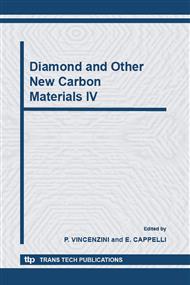p.9
p.17
p.24
p.31
p.37
p.44
p.50
p.55
p.61
Thermal CVD Growth of Carbon Nanotubes Thick Layers
Abstract:
Since their discovery, carbon nanotubes received a great deal of attention because of unique physical and chemical properties. However, in order to become of interest in the field of super resistant fibers for nanocomposite materials or in the production of textile material, very long carbon nanotubes are needed. Massive samples of well packed, vertically aligned and very long selfstanding multi wall carbon nanotubes (MWNT) were synthesized on uncoated silicon by a very efficient thermal CVD process, which involved the co-evaporation of camphor and ferrocene in a nitrogen atmosphere. We obtained structures with diameter between 20 and 80 nm with an average growth rate of about 400 nm/s, organized in thick carpets of entangled nanotubes. By the weight of the deposited carpet of MWNTs (density circa 0.8 g/cm3) the conversion of about 30% of the total hydrocarbon feedstock was calculated. Morphology and physical properties were characterized by electron microscopy techniques, Micro- Raman spectroscopy and thermogravimetric analysis. The analyses performed showed the absence of secondary carbonaceous products, whereas only 6% in weight of ferromagnetic iron clusters are present. BET analysis was used to calculate the porosity and the specific surface area density of the as grown samples, which resulted approximately 70 m2/g. Hydrophobicity of the CNT carpet was also investigated.
Info:
Periodical:
Pages:
37-43
Citation:
Online since:
October 2006
Authors:
Keywords:
Price:
Сopyright:
© 2006 Trans Tech Publications Ltd. All Rights Reserved
Share:
Citation:


